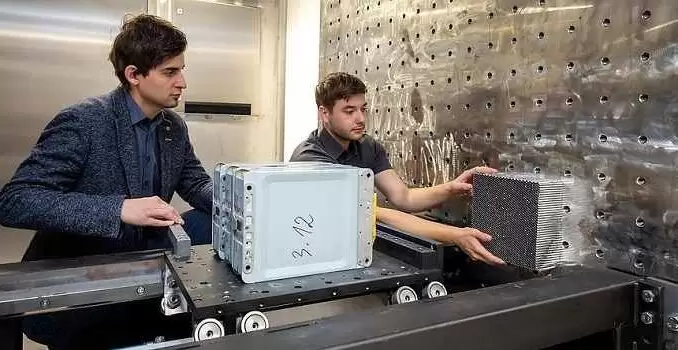
Visits: 1
– Studies by TU Graz show that the older the electric vehicle (EV) traction battery, the less danger it poses. Now researchers and industry partners want to set parameters for the subsequent use of discarded batteries.
Courtesy TU Graz: As part of the “SafeBattery” project, a team from the Graz University of Technology (TU Graz) has been investigating the behavior of lithium-based batteries in electric vehicles under collision loads for the past four years. “The performance of the new battery cells is widely known, so we deal with the entire life cycle,” explains project manager Christian Ellersdorfer at the Institute of Vehicle Safety. Together with industry partners such as AVL, Audi and Daimler, the research was conducted in scenarios that a battery can experience throughout its life: for example, vibrations and strong accelerations caused by parking bumps, serious accidents and constant loading and unloading of batteries.
Changes due to loading and unloading
With the help of crash tests, simulation models and calculation methods, the researchers were able to determine that vibrations and accelerations hardly affect the behavior of the batteries. However, more significant mechanical and electrical changes were seen as a result of the constant charging and discharging of the battery. Battery cells aged in this way are more rigid under mechanical load. “But the changes don’t necessarily mean that batteries will become more dangerous over time. On the contrary. The sum of influences makes them safer over time because they also lose electricity, ”says Ellersdorfer. The investigations by Ellersdorfer et al show that cells with a strongly reduced capacity content have a weakened course of the so-called thermal leak after an internal short circuit. Thus, the reduced energy potential of old batteries decreases the likelihood of accidental battery fires.
Benefit for the automotive industry
Thanks to the research results, manufacturers now know what to expect from a battery cell. This allows for projects with material savings and greater efficiency, as explained by Ellersdorfer: “So far, the battery has been installed so that deformations could be excluded in all imaginable scenarios. Now manufacturers can make better use of the installation space. security checks on a new cell are valid for battery life. “
Approval of EVBs for a second life
In the battery life timeline, the SafeBattery consortium is now taking it a step further. In the recently launched COMET SafeLIB project, changes in traction batteries for electric vehicles are being examined in more detail in conjunction with other partners as: LIT Law LAB, Infineon, Fronius, Mercedes, in order to be able to derive safety factors for later use. “Batteries used with an energy capacity of 80 percent are no longer suitable for electric vehicles, but are very suitable for storage of stationary energy or for machine tools. For the first time, we are determining generally valid parameters in the area of safety,” says Ellersdorfer, describing the project.
The researchers will use the world’s only test bench technology for battery safety at the Battery Safety Center Graz, which opened in late 2020. There, the initial life of a battery cell can be examined at a level of detail without precedents. The legal framework for reuse (for example, the issue of liability for consequential damages) is also taken into account. In addition to the so-called “health status”, which reflects the existing residual capacity and performance of a battery cell, a “safety state” must be defined ultimately, by which the safety status of a battery can be assessed by throughout the entire life cycle. SafeLIB runs for four years and ends in 2025. The Austrian Research Promotion Agency FFG is funding the project with a total of € 6 million (see FFG Fact sheet; German only).
Scientific partners:
- TU Graz | Vehicle Safety Institute
- TU Graz | Institute of Chemistry and Materials Technology
- Johannes Kepler University Linz
- Virtual Vehicle Research Center
- Corporate partners:
- Audi AG2
- AVL List GmbH
- Dr. Ing. H.c.F. Porsche AG
- DYNAmor GmbH
- Fill GmbH
- Fronius International GmbH
- Infineon Technologies AG
- Mercedes Benz AG
- Wacker Neuson Linz GmbH
Both research projects are anchored in the the Field of Expertise “Mobility and Production”, one of the five areas of strategic focus of TU Graz.
Contact: Christian ELLERSDORFER – Prof. Dipl.-Ing. Dr.techn. / TU Graz | Vehicle Safety Institute/ christian.ellersdorfer@tugraz.at
The project leader, Christian Ellersdorfer, is researching the safety of electronic batteries at the Vehicle Safety Institute of Graz University of Technology. © Lunghammer – TU Graz
Related article: Novel approach for more sustainable batteries
Leave a Reply